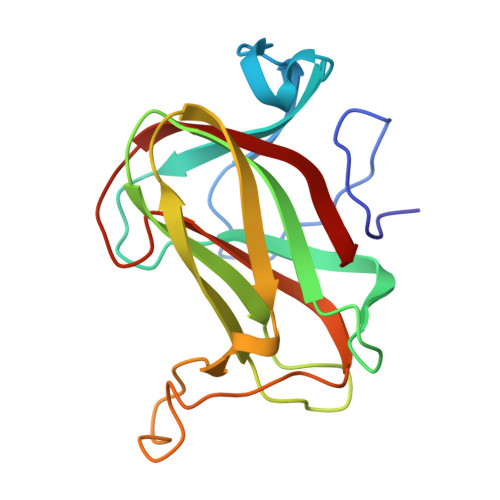Unveiling the role of novel carbohydrate-binding modules in laminarin interaction of multimodular proteins from marine Bacteroidota during phytoplankton blooms.
Zuhlke, M.K., Ficko-Blean, E., Bartosik, D., Terrapon, N., Jeudy, A., Jam, M., Wang, F., Welsch, N., Durwald, A., Martin, L.T., Larocque, R., Jouanneau, D., Eisenack, T., Thomas, F., Trautwein-Schult, A., Teeling, H., Becher, D., Schweder, T., Czjzek, M.(2024) Environ Microbiol 26: e16624-e16624
- PubMed: 38757353
- DOI: https://doi.org/10.1111/1462-2920.16624
- Primary Citation of Related Structures:
8QX6 - PubMed Abstract:
Laminarin, a β(1,3)-glucan, serves as a storage polysaccharide in marine microalgae such as diatoms. Its abundance, water solubility and simple structure make it an appealing substrate for marine bacteria. Consequently, many marine bacteria have evolved strategies to scavenge and decompose laminarin, employing carbohydrate-binding modules (CBMs) as crucial components. In this study, we characterized two previously unassigned domains as laminarin-binding CBMs in multimodular proteins from the marine bacterium Christiangramia forsetii KT0803 T , thereby introducing the new laminarin-binding CBM families CBM102 and CBM103. We identified four CBM102s in a surface glycan-binding protein (SGBP) and a single CBM103 linked to a glycoside hydrolase module from family 16 (GH16_3). Our analysis revealed that both modular proteins have an elongated shape, with GH16_3 exhibiting greater flexibility than SGBP. This flexibility may aid in the recognition and/or degradation of laminarin, while the constraints in SGBP could facilitate the docking of laminarin onto the bacterial surface. Exploration of bacterial metagenome-assembled genomes (MAGs) from phytoplankton blooms in the North Sea showed that both laminarin-binding CBM families are widespread among marine Bacteroidota. The high protein abundance of CBM102- and CBM103-containing proteins during phytoplankton blooms further emphasizes their significance in marine laminarin utilization.
Organizational Affiliation:
Pharmaceutical Biotechnology, Institute of Pharmacy, University Greifswald, Greifswald, Germany.















